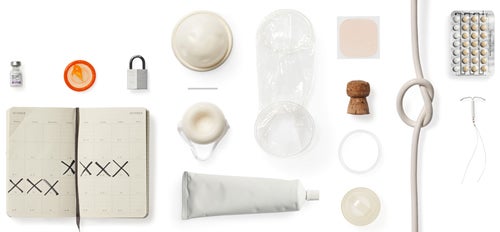
My job is to tell people how great birth control is. It’s a worthy task and a message I believe in. But it doesn’t mean my personal experiences with birth control are always perfect. As of 2017 there are 17 types of birth control available in the U.S., and I’ve tried more than half of them. Sometimes you have to kiss a few frogs.
Now, 22 weeks into my first pregnancy, I’m so grateful for the various birth control methods that allowed me to decide when to enter this new phase of life. It is no secret that reliable contraceptive access has made a difference for society, but the impact on an individual level is no less compelling. As my husband and I prepare to bring a new human into the world, I give thanks every day that this was something we could plan.
In honor of National Women’s Health Week this year, here’s some real talk about the wondrous array of contraceptive tools that made the planning possible.
Old-school classics: Condoms and “pull and pray”
I think I had something resembling sex ed in high school, but I don’t remember much about it. There were no bananas to put condoms on—that much I’m sure of. Still, my friends and I knew about condoms, and we knew we were supposed to use them, like, always. It helped that you could get them at a gas station or drug store in relative anonymity.
Another method we learned about early on was withdrawal. (It’s no coincidence that five myths about pulling out, busted is the all-time most popular article on Bedsider.org.) Pulling out, aka the withdrawal method, definitely isn’t the most effective birth control method, but it is accessible. There’s nothing to buy and no doctor’s visit required. And, fun fact, while about 1 in 5 couples will get pregnant within a year relying on withdrawal alone, recent research suggests that combining the pull-out method with other birth control methods may actually be a good way to be extra careful.
My old-school classics take-away: Both condoms and withdrawal are super accessible and work best when paired with another method of birth control. Here’s a character we made up to tell you more:
Hormonal birth control: You name it, I’ve (probably) tried it
The first hormonal method I ever tried was the Depo shot. I got about three injections before deciding it wasn’t for me. Did I decide to stop because my boyfriend broke up with me, or because my ballet teacher pulled me aside for a heart-to-heart to ask if I was taking a new medication that might be causing weight gain? We may never know for sure. I do know that looking back months after my last shot, it seemed clear that the shot had negatively affected my emotional well-being.
Next I tried two different kinds of combined pills (one made me feel physically and emotionally miserable; the other was totally fine). After that I tried the patch. A few years later, the NuvaRing, which I used on and off throughout my 20s and into my 30s.
Here are my TLDR take-aways on hormonal methods:
1) Side effects really are a thing, and just because research hasn’t found a trend on a population level doesn’t mean you’re crazy if you think your birth control is having a negative effect on you. Trust yourself and don’t settle. (That goes for non-hormonal methods too.)
2) Hormones are a little mysterious, and it’s hard to know how the specific types, amounts, and combinations used in different birth control options will affect your unique body, i.e., just because you had a bad reaction to one hormonal birth control doesn’t mean you’ll have the same experience with another.
If at first you don’t succeed: Joining Team IUD
It’s not only health care providers who love IUDs—they also seem to be wildly popular among the broader reproductive health community. So when I got into a new relationship in my early thirties, I decided it was time to try one.
I opted for the hormone-free ParaGard. The insertion hurt but seemed to go smoothly, though I had intense cramping for days afterward. I remember having the sense that my uterus was working hard to reject this unwelcome object. A few days in, I checked the strings to make sure the IUD was in place and thought I felt something hard in my cervix. I was afraid it might be the bottom of the T, but decided to keep calm and hope I was mistaken. Several days later, I checked again and only felt the strings, so I resolved to ask my health care provider about it at my six-week follow-up and not worry too much before then.
At the six-week follow-up, I told my provider what I’d felt and asked her to check carefully that the IUD was in place. Sure enough, she found what I was talking about and ordered an ultrasound to confirm. I had my partially expelled IUD removed that day and went home to cry and regroup.
After some soul-searching and research (which resulted in this question on Bedsider), I decided to try again. The second time around, the ParaGard stayed in place until my next period, when I experienced the worst menstrual cramps of my life and the same sensation of my uterus trying to expel the foreign invader. Ultimately, it won the battle—at least partially. When I checked my strings after days of cramping, I felt the bottom of the T in my cervix once again.
After having the second IUD removed, I went back to the ring. Not being able to join Team IUD was frustrating, and I thought the ring might be negatively affecting my digestion and my libido. (Note: There’s no research I’m aware of to back up this perception.) I kept wondering if my uterus was unequivocally anti-IUD, or just anti-ParaGard.
A year-plus later, I had a check-up with a new provider and told her about my ParaGard experience. She suggested the Skyla IUD if I was up for one more try.
For me and the IUD, the third time was the charm. The Skyla saw me through a two-year grad program with very few side effects (one of which was the welcome absence of periods, which happens for about 1 in 17 people who use it). When I got the Skyla removed after 2.5 years, it was because I wanted to try to get pregnant.
And then, one day, prevention is no longer the goal
Guess what else has side effects? Pregnancy. I feel so lucky to be at a point in my life when even nausea and fatigue are weirdly exciting, because I know my body is working to support the pregnancy.
I got to this point thanks to solid birth control access. Health insurance covered much of my care throughout this journey, including all three IUD insertions and removals.
Birth control isn’t one-size-fits-all—for most of us it’s a complicated, dynamic, decades-long process. That’s why ongoing access to reproductive health care, including the full range of contraceptive methods, is so important—and why five months into a very planned pregnancy, I appreciate my own winding path more than ever.
Birth control isn’t perfect. But it’s worth it. There are so many things in life we can’t control—let’s give thanks for the fact that bringing a new person into the world is one of them. And let’s make sure that everyone, regardless of their location or personal circumstances, has the ability to do so.
